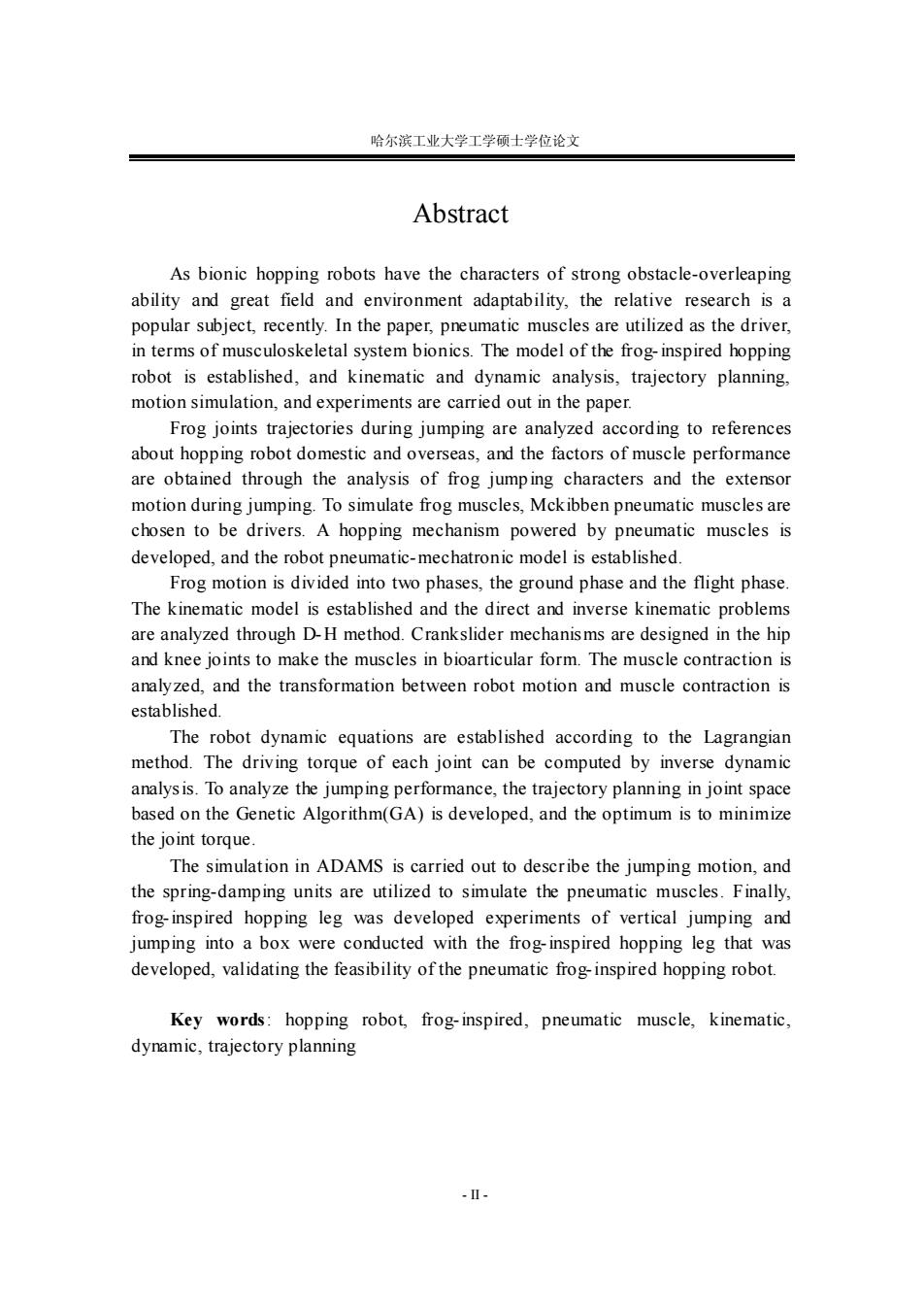正在加载图片...

哈尔滨工业大学工学硕士学位论文 Abstract As bionic hopping robots have the characters of strong obstacle-overleaping ability and great field and environment adaptability,the relative research is a popular subject,recently.In the paper,pneumatic muscles are utilized as the driver, in terms of musculoskeletal system bionics.The model of the frog-inspired hopping robot is established,and kinematic and dynamic analysis,trajectory planning. motion simulation,and experiments are carried out in the paper. Frog joints trajectories during jumping are analyzed according to references about hopping robot domestic and overseas,and the factors of muscle performance are obtained through the analysis of frog jumping characters and the extensor motion during jumping.To simulate frog muscles,Mckibben pneumatic muscles are chosen to be drivers.A hopping mechanism powered by pneumatic muscles is developed,and the robot pneumatic-mechatronic model is established. Frog motion is divided into two phases,the ground phase and the flight phase. The kinematic model is established and the direct and inverse kinematic problems are analyzed through D-H method.Crankslider mechanisms are designed in the hip and knee joints to make the muscles in bioarticular form.The muscle contraction is analyzed,and the transformation between robot motion and muscle contraction is established. The robot dynamic equations are established according to the Lagrangian method.The driving torque of each joint can be computed by inverse dynamic analys is.To analyze the jumping performance,the trajectory planning in joint space based on the Genetic Algorithm(GA)is developed,and the optimum is to minimize the joint torque. The simulation in ADAMS is carried out to describe the jumping motion,and the spring-damping units are utilized to simulate the pneumatic muscles.Finally, frog-inspired hopping leg was developed experiments of vertical jumping and jumping into a box were conducted with the frog-inspired hopping leg that was developed,validating the feasibility of the pneumatic frog-inspired hopping robot. Key words:hopping robot,frog-inspired,pneumatic muscle,kinematic, dynamic,trajectory planning -1-哈尔滨工业大学工学硕士学位论文 - II - Abstract As bionic hopping robots have the characters of strong obstacle-overleaping ability and great field and environment adaptability, the relative research is a popular subject, recently. In the paper, pneumatic muscles are utilized as the driver, in terms of musculoskeletal system bionics. The model of the frog-inspired hopping robot is established, and kinematic and dynamic analysis, trajectory planning, motion simulation, and experiments are carried out in the paper. Frog joints trajectories during jumping are analyzed according to references about hopping robot domestic and overseas, and the factors of muscle performance are obtained through the analysis of frog jumping characters and the extensor motion during jumping. To simulate frog muscles, Mckibben pneumatic muscles are chosen to be drivers. A hopping mechanism powered by pneumatic muscles is developed, and the robot pneumatic-mechatronic model is established. Frog motion is divided into two phases, the ground phase and the flight phase. The kinematic model is established and the direct and inverse kinematic problems are analyzed through D-H method. Crankslider mechanisms are designed in the hip and knee joints to make the muscles in bioarticular form. The muscle contraction is analyzed, and the transformation between robot motion and muscle contraction is established. The robot dynamic equations are established according to the Lagrangian method. The driving torque of each joint can be computed by inverse dynamic analysis. To analyze the jumping performance, the trajectory planning in joint space based on the Genetic Algorithm(GA) is developed, and the optimum is to minimize the joint torque. The simulation in ADAMS is carried out to describe the jumping motion, and the spring-damping units are utilized to simulate the pneumatic muscles. Finally, frog-inspired hopping leg was developed experiments of vertical jumping and jumping into a box were conducted with the frog-inspired hopping leg that was developed, validating the feasibility of the pneumatic frog-inspired hopping robot. Key words: hopping robot, frog-inspired, pneumatic muscle, kinematic, dynamic, trajectory planning